Daylily Middendorf: description and tips for growing
Daylilies attracted by the discreet beauty of flowers and ease of care. They are durable, grow quickly, do not require watering, and are not affected by diseases and pests.
Content:
- Daylilies - what are these plants?
- Features of Middendorf daylily
- Reproduction methods
- Seed propagation
- Everything you need to know about boarding
- Daylily care
- Using the Middendorf daylily
Daylilies - what are these plants?
Daylilies got their name for the resemblance of a flower to a lily. But these are different plants. Lily - bulbous, daylily rhizome, with filamentous adventitious roots. In the modern classification, it belongs to the Lileinikovs subfamily, which in the modern classification was introduced into the Ksantorreev family.
The scientific name of the daylily Hemerokallis means a beautiful flower opened one day. In a word, this is reflected in the less commonly used name of the plant - krasnodne (one day is beautiful).
There are about 20 natural plant species, most of which are found in eastern Asia.
Daylily Middendorf belongs to natural species. It grows in China, the Far East, and Manchuria. There, its thickets can be found in clearings and edges of deciduous forests.
It was named after the Russian scientist A. Middendorf. The flower has been cultivated as a garden plant since 1866. During this time, many new varieties and hybrids were created on its basis.
Features of Middendorf daylily
Middendorf daylily of early flowering period. The rhizome is thick, the leaves are linear, about 2 cm wide. As they grow, they sag, revealing thin, straight peduncles. The height of the bush is about 50 cm, the peduncles are 80 cm. At the top of each is an inflorescence with several buds.
Funnel-shaped flowers with bright yellow-orange petals open in May, and the flowering process lasts 20 days, until June.
Each flower is opened no more than a day, rarely two days. Therefore, the flowering time is ensured by a large number of buds. Flowers open in the morning and close in the evening. Sometimes the plant blooms again, in August. In place of the flower, a fruit is formed - a box with three sides. Seeds are black, shiny, ripen in July.
The flower is common for daylily plants, simple, with a six-part corolla. Its open diameter is about 11 cm, length is 9 cm. It has a sharp, but not very pleasant smell.
Reproduction methods
Middendorf daylily reproduces:
- By dividing the bush.
- Children.
- Seeds.
The main breeding method of Middendorf daylily is by dividing the bush. For this, an adult, approximately five-year-old bush is used. It is dug up in early spring, before the leaves begin to develop, or in autumn. But in this case, the plant must have time to take root before frost. Transplant deadlines are early September. Remove damaged, rotten and dry adventitious roots. Process the cut points wood ash.
Usually, daylily rhizomes tolerate shipping and storage well. They can stay in a shaded area for up to 3 weeks, but it is best to hide them in wet sand.If the rhizome has been dug for a long time, before planting it can be soaked for a couple of hours in a growth stimulator (humate, epin). Before planting, the leaves are cut to 10 cm. It is not necessary to dig up the entire bush. Often it is almost impossible to do this, because it is very wide. You can separate the area from the bush that grows closer to the edge and is slightly separated from the general. To do this, cut the rhizome from top to bottom with a sharp disinfected shovel and cut off a small piece. They take it out of the ground, remove damaged roots, treat it with charcoal and plant it in the ground. The main bush is not watered for several days, they wait until the wounds heal.
It is sometimes difficult to dig out the rhizome, since the long suction roots are deep in the ground, and the young ones are located only around the bush.
Therefore, full-fledged delenki suitable for planting are obtained only from the outer part. Internal ones are first grown on separate beds for a year or two, and then planted in a permanent place. Sometimes it is possible to propagate the Middendorf daylily by children, which are formed after flowering on the tops of the shoots from dormant buds. They consist of several leaves that extend from the point of growth. They have no roots. Such a stalk is separated from the shoot, leaving up to 4 cm of the stem, planted in light moist soil and covered with glass or film. Shade before rooting, watered, sprayed. In the spring they are planted in the ground.
Seed propagation
Daylily is propagated by seeds. But the species properties will not be preserved if pollination occurs with a daylily of another species. The result of cultivation can be interesting, since it becomes possible to obtain a plant of a new species.
Daylily reproduces by self-sowing, you can sow seeds before winter or grow in a greenhouse.
But for this he needs pollinators. If they are not there, the seeds are not set at all or very few are formed. In this case, artificial pollination should be used. Seeds need to be sown shortly after ripening because they lose their germination.
If they are sown in spring, seeds are stratified in the winter months. For this, they are kept in wet sand for up to 2 months. The room temperature should be around 3 ° C.
The seeds are not afraid of the cold, so they can be sown in a cold garden bed or greenhouse to a depth of 2 cm. Seedlings begin to bloom in the second year, and in the third year a full-fledged plant is formed.
Everything you need to know about boarding
The place for growing the Middendorf daylily is chosen sunny or slightly shaded. It can grow even in the shade, but it will not bloom. Daylily flowers will be able to fully open only in a well-lit place.
The daylily does not have any special requirements for the soil. Grows well on humus-rich garden soils. If they are poor, they bring compost, peat. On dry sandy ones, clay is added, which will retain moisture. Clay soils are diluted with sand. He will make them looser.
To plant the Middendorf daylily, a pit is prepared with a depth of about 30 cm.
Humus, peat are introduced, potash and phosphorus fertilizers are added. Mix thoroughly. If flooding is possible on the site, a drainage layer must be provided. Pour a mound of the prepared mixture onto the bottom of the pit. Establish the rhizome, level the roots.
Do not deepen the root collar deeper than 2 cm, otherwise the daylily will bloom weakly. They fill the pit with earth, water it, compact the soil. Mulch with peat, sawdust or cut grass. When planting one or several bushes, take into account that the bush will grow over several years and will have a diameter of about 70 cm.
Daylily care
Daylilies are not affected by any diseases. They have no pests. Therefore, caring for the plant after planting consists of regular, but not frequent watering:
- In subsequent years, he does not need watering, except in cases of severe drought. The daylily has a powerful root system, therefore it can get moisture from great depths. It is best to provide moisture at a depth of 20 cm and keep the top layers dry.
- The plant does not like flooding, its roots can rot during heavy rains. If this happens, the leaves begin to turn yellow and wither. In this case, you need to urgently dig up the bush. Leaves are cut. Rinse with clean water, examine the condition and the presence of rot. Cut off the affected areas with a sharp knife. They are treated with foundation. When the cuts are dry, the rhizome is planted in a new place, shaded from direct sunlight with mulch. Water in moderation.
In the fall, the leaves of the daylily turn yellow and droop. But in most regions, they do not have time to complete their life cycle and fall under the snow. Sometimes the leaves turn green before frost. When the temperature drops to -1 ° C, they disappear. Depending on the climatic zone, the bush begins to develop in early or mid-April. If cold weather comes during flowering, the flowering becomes weak, the flowers become smaller, do not fully open and fall off.
Using the Middendorf daylily
In China, Middendorf's daylily flowers have long been eaten. They give a special taste and aroma to millet. It is boiled with flowers, then poured with soy sauce and vinegar. Young leaves are also eaten, after boiling them.
The daylily has medicinal properties. Its leaves and roots contain cardiac glycosides. In our latitudes, Middendorf's daylily is not used for food. It is grown as an ornamental plant. It is planted singly, in groups. It will decorate almost any flowerbed, mixborder. The leaves remain decorative after flowering.
More information can be found in the video:



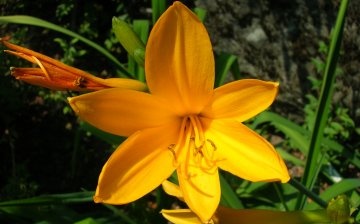

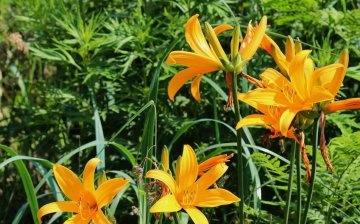
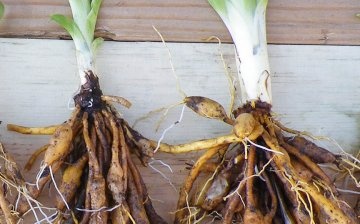
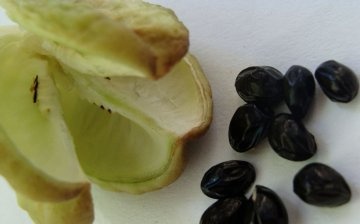
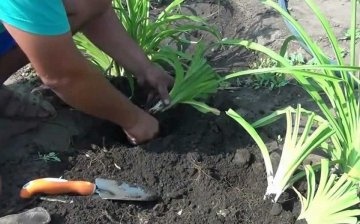
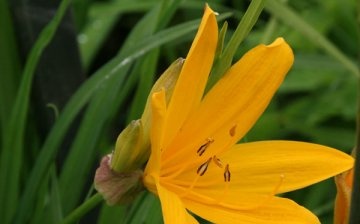
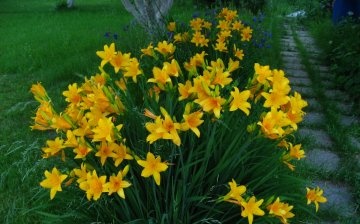








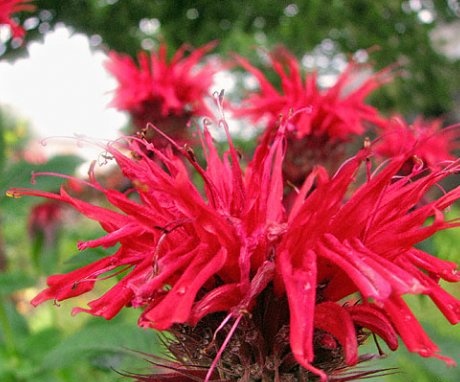

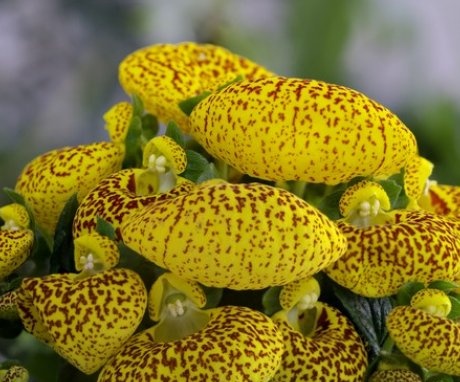
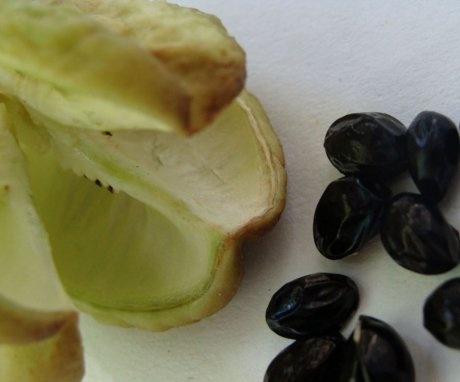


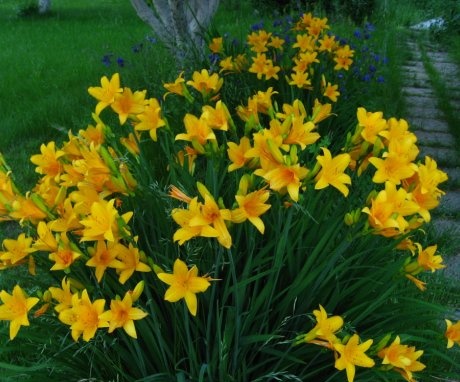
A very beautiful flower and quite unpretentious. They bloom long and powerfully. I think that they are very suitable for a flower bed, especially if it is large and plays with different colors. We have a Daylily too! And you?